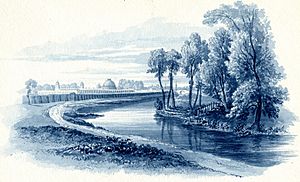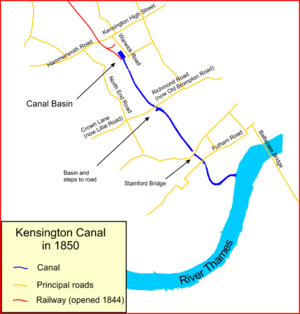Kensington Canal facts for kids
The Kensington Canal was a waterway, about two miles long, built in London. It opened in 1828 and connected the River Thames to a basin near Warwick Road in Kensington. This canal followed the path of an old stream called Counter's Creek. It had one lock (a water elevator for boats) and places for boats to load and unload goods.
However, the canal was not very successful. It didn't make much money, so a railway company bought it. They built a railway line right next to the canal. Later, the canal itself was filled in, and another railway line was built on top of it. Today, one of these lines is part of the London Underground's Wimbledon branch, and the other is the West London Line.
Contents
Why Was the Canal Built?
Before the canal, Counter's Creek was just a small stream flowing south from Kensal Green to the River Thames. In 1822, a man named Lord Kensington saw how successful other canals, like the Regent's Canal, were. He thought a canal could help bring goods and materials from the London docks to Kensington. At that time, Kensington was more like a quiet countryside area, not well connected to central London.
Lord Kensington asked his surveyor, William Cutbush, to design a plan to turn the creek into a canal.
Getting Permission and Funding
After some changes, Cutbush's plan was approved by Parliament in 1824. This meant the Kensington Canal Company could be formed. Lord Kensington and his friends, including Sir John Scott Lillie, were the main owners. They thought the canal would cost about £7,969 to build. The company raised £10,000 by selling shares, and they could raise an extra £5,000 if needed.
However, this cost estimate was way too low! John Rennie, a famous engineer, said it would cost more than £34,000 to build the canal properly. This included rebuilding Stamford Bridge, which the canal would pass under. So, the company had to get permission in 1826 to raise another £30,000. Even with these much higher costs, they still hoped to extend the canal further north to connect with the Grand Junction Canal at Paddington.
Building the Canal
Work on the canal started in 1826. The main builder was Robert Tuck. But there were delays because Tuck went bankrupt. Finally, after many difficulties, the Kensington Canal officially opened on 12 August 1828.
The Canal Opens!
The opening day on August 12, 1828, was a big event! The Times newspaper reported that many people came to watch. Lord Kensington and his friends boarded a fancy boat at Battersea Bridge and sailed up the new canal. They were cheered by the crowds, and a band played "God Save the King." Later, Lord Kensington hosted a big dinner, and he also paid for a meal for about 200 of the workers.
The Annual Register described the canal, saying it was "one hundred feet broad, and capable of affording passage for craft of one hundred tons burden." This meant it was wide enough for large boats. The main basin (where boats could turn around) was 400 feet long and 200 feet wide. It was the only way to get goods by water to Kensington. The canal cost about £40,000 to build.
Problems with the Canal
Even though the opening was grand, the canal didn't get much use. By the mid-1830s, people like Lord Holland were calling it a complete failure. It even became a joke in Punch magazine!
One big problem was that the River Thames is tidal where the canal joined it. This meant the canal was also tidal up to its lock. The tides brought a lot of mud and silt into the canal, and there wasn't enough fresh water from Counter's Creek to wash it away. This made it hard for boats to pass. Also, boats could only use the canal for very short times each day, depending on the tides, which made it inconvenient.
The Railway Takes Over
The canal owners had dreamed of extending it further north, but the first section cost so much that extending it was impossible.
In the 1830s, railways were becoming popular. Big railway lines like the London and Birmingham Railway and the Great Western Railway were being planned. These lines would pass north of Kensington. People wanted a way to move goods from these railways to the London docks. So, they thought about building a railway branch line to the canal. Goods could then be transferred from trains to river boats (called lighters) at the canal basin.
The Canal Becomes a Railway Line
A railway company called the Bristol, Birmingham and Thames Junction Railway was formed. In 1836, this company bought the Kensington Canal for £36,000. They paid £10,000 in cash and gave the rest in shares of their new company.
The railway company later changed its name to the "West London Railway". It built a short railway line from Willesden, connecting to the main railway lines there, all the way to the canal basin. In 1846, the London and Birmingham Railway leased this new railway line. The Kensington Canal Company was officially closed down in the same year.
The combination of the railway and the canal didn't work well either. The hoped-for traffic, where goods would be moved between trains and boats at Kensington, never happened. The big railway companies needed a direct rail connection to lines south of the Thames. So, in 1859, several railway companies got permission to extend the railway south from Kensington. This meant converting the canal itself into a railway line!
At the southern end, the railway moved a bit west of the canal and crossed the Thames on a large bridge. This left a small part of the original canal still open, from the Thames almost to Stamford Bridge. This small section was used by flour mills and a gas works until 1967, when all traffic stopped.
The building of the railway over the rest of the canal, and later railway developments, completely removed the canal. Today, if you want to see where the canal used to be, you can look at the route of the modern West London Line from the Thames up to Kensington (Olympia) station.



